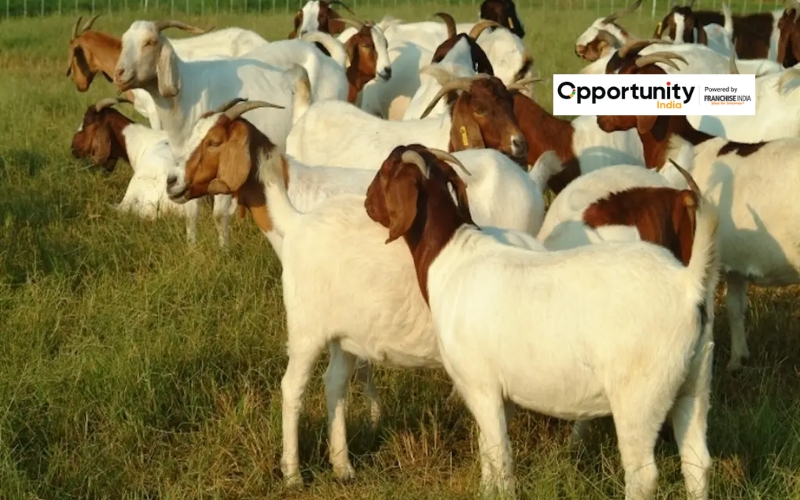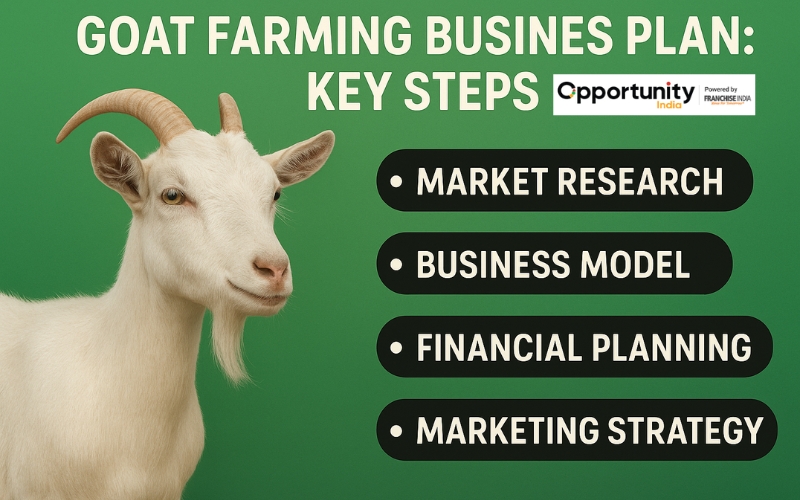
In India, goat farming is rapidly becoming one of the most lucrative animal industries. Goats are becoming a more popular source of income for aspiring farmers and agri-entrepreneurs due to the rising demand for goat meat (chevon), milk, and even manure. Goats adapt well to the various temperatures and terrains found throughout the nation, and starting doesn't require a significant financial commitment. You are in the proper place if you are thinking about this profitable endeavor. From planning and choosing the best breed to handling housing, feeding, and sales, let's explore the essential processes of starting a profitable goat farming business.
Understanding Goat Farming Business in India
In 2024, the size of the Indian animal husbandry market was INR 1,244.6 billion. According to IMARC Group's forecast, the market would increase at a compound annual growth rate (CAGR) of 6.3% from 2025 to 2033, reaching INR 2,218.8 billion. Goat farming has become one of the most lucrative livestock industries in India in recent years, particularly for small and marginal farmers. Young people in rural areas, agribusiness owners, and even urban investors are showing a lot of interest in this venture due to its cheap investment requirements and great returns.
Also Read: 9 Profitable Pet Business Ideas
In India, goat farming, which is sometimes referred to as the "poor man's cow," is quickly becoming a very profitable and sustainable enterprise. It offers both seasoned farmers and budding entrepreneurs a fantastic chance due to its minimal initial investment, great demand for its variety of products, and flexibility to different climatic conditions. The first and most important step in turning your agricultural dreams into a successful business is creating a well-organized goat farming business plan.

Why Start a Goat Farming Business in India?
It is no accident that goat farming is becoming more popular. It has several strong benefits that make it a desirable endeavor:
- High Demand: Dietary choices and health consciousness are the main drivers of India's steady and rising demand for goat milk and meat (chevon). Goat meat is a healthier option because it is lean and lower in cholesterol.
- Minimal Initial Investment: Establishing a small to medium-sized goat farm costs a lot less money than starting a larger animal operation, such as a cattle farm. It's even possible to start with a small herd and grow it over time.
- Prolific Breeders: Goats commonly give birth to several children (twins and triplets are common) and have a shorter gestation period (about 5 months), which enables quick returns and rapid herd expansion.
- Adaptability: Goats are resilient creatures that may flourish in a variety of agroclimatic settings, such as semi-arid and arid ones. Their efficient feed conversion is another of their well-known traits.
- Multipurpose Animal: Goats produce a variety of useful goods, such as meat, milk, skin, dung, and fiber (cashmere, mohair). There are other sources of revenue due to this diversification.
- Easy Management: Both seasoned farmers and beginners can use goats because they are often calm and easy to handle.
- Manure as a Resource: Goat dung is a great organic fertilizer that is frequently in high demand for organic farming since it is full of vital elements like potassium, phosphorus, and nitrogen.
Also Read: How to Start a Tea Business in India?
Types of Goat Farming
It's crucial to understand the many forms of goat farming according to their main function before beginning any planning:
- Meat Production: The most common type of goat farming in India is meat production, which is a result of the strong demand for goat meat. Preferred breeds are those with a reputation for quick growth and high-quality carcasses.
- Milk Production: Goat milk is becoming more well-liked due to its simple digestion and high nutritional content, particularly for young children and the elderly.
- Fiber Production: Some goat breeds, such as Angora and Pashmina, are raised especially for their priceless fiber, which includes cashmere and mohair.
- Breeding Stock: A few farms focus on producing and offering premium breeding bucks and does for sale to other farmers.
- Integrated Farming: Goat husbandry is often combined with other agricultural pursuits, such as crop cultivation, by farmers to optimize resource use and revenue.
Key Steps to Start a Goat Farming Business
It is extremely important to have a well-thought-out plan to start a goat farming business venture. Here's a step-by-step guide:
Researching the Market and Choosing a Niche
- Define Demand: Understand the need for goat products in the area before proceeding. Are there robust markets for breeding stock, milk, or meat? Identify possible customers, such as nearby butchers, eateries, dairy producers, private customers, or other farms.
- Assess the Competition: Explore the goat farms currently operating in your region. What are their advantages and disadvantages? How can you set your goods and services apart?
- Identify Your Niche: Choose whether to concentrate on breeding, meat, milk, or a combination of these based on your study. This will direct your choice of breed and general agricultural operations.
Choosing the Right Location
Although goats are incredibly resilient and can live in a variety of environments, picking the correct spot is still important. There must be ample room for eating or grazing, convenient access to clean water, and adequate ventilation. Make sure the local market, veterinary clinics, and feed suppliers are all within easy driving distance of your farm.
Also Read: How to Start a Banana Farming Business?
The ideal piece of land is level, slightly raised, and properly drained. This avoids waterlogging, which raises the risk of infection and sickness. You can run a small-scale business efficiently even if you have limited space.

Choosing the Best Breeds of Goats
Your business may succeed or fail based on this phase. The breed you select should be suitable for either milk, meat, or both. Among the most well-liked goat breeds in India are the Sirohi, Boer, Barbari, Osmanabadi, Black Bengal, and Jamunapari.
Boer, Sirohi, and Black Bengal are excellent alternatives if you are primarily interested in meat. Goats of the Jamunapari and Osmanabadi breeds are favored for milk production because of their increased milk supply. For increased productivity, you can even crossbreed goats, although it's important to speak with a livestock specialist first.
Building Appropriate Housing for Goats
Maintaining your goats' health and preventing sickness requires proper housing. Since goats dislike damp or unclean conditions, your shelter should be dry, well-ventilated, and simple to maintain. Waste can fall through an elevated shed with a slat floor, which also helps to keep water from building up.
Space is also important. Each goat will typically require 1.5 to 2 square meters. Make sure your shelter has separate spaces for sick animals, pregnant does, and kids, and that it shields them from inclement weather, particularly rain and cold. Remember to fence off your land so that goats won't get lost or be attacked by predators.
Nutrition and Feeding
Unlike cows, which graze, goats browse. Instead of grass, they favor twigs, leaves, and plants. Nevertheless, for the best growth and production, you still need to make sure they're eating a balanced diet.
Mineral supplements, grains, dry fodder (like wheat or paddy straw), and green fodder (like lucerne or Napier grass) will all be beneficial. There should always be access to clean drinking water. Additionally, the goat's age, size, and whether it is pregnant or nursing can all affect how much feed it consumes. In addition to improving the quality of meat and milk, a proper diet increases immunity.
Also Read: How to Start a Tiffin Service Business from Home?
Health Care and Disease Management
Regarding livestock, prevention is always preferable to treatment. Goat pox, foot and mouth disease, PPR (Pest des petits ruminants), and internal and external parasites are among the frequent ailments that goats are prone to. These problems have the potential to destroy your entire herd and your investment if they are not dealt with immediately.
Promoting and Selling Your Goods
Raising healthy goats is only one aspect of running a successful goat farm; another is marketing and selling the animals effectively. You can sell live goats, goat meat, milk, manure, and even goat skins, depending on your area of expertise.
Live goats and meat are frequently sold in local markets, butcher shops, and meat dealers. If you're a milk producer, you can sell directly to customers or supply nearby dairies. Both organic farms and urban gardens are interested in organic goat manure. Selling directly to consumers has never been simpler due to the growth of social media and online marketplaces.
Investment Breakdown for 100 Goats (Approximate)
| Component | Cost (INR) |
|---|---|
| 100 Goats (90 does + 10 bucks) | ₹7,50,000 – ₹9,00,000 |
| Goat Shed (1000 sq.ft.) | ₹6,00,000 |
| Feed and Fodder (Yearly) | ₹2,50,000 |
| Vaccination & Health Care | ₹50,000 |
| Labor (1 caretaker) | ₹1,20,000/year |
| Miscellaneous (water, electricity, tools) | ₹80,000 |
| Total Investment | ₹18,50,000 – ₹20,00,000 |
In India, goat farming has the potential to become an attractive agribusiness model that produces consistent revenue, making it more than just a rural survival. You can make this into a scalable and sustainable business with the right breed selection, marketing strategy, and careful planning. Goat farming may be the first step toward success in the livestock sector for anyone looking to pursue a career in agriculture, agribusiness, or passive income.

